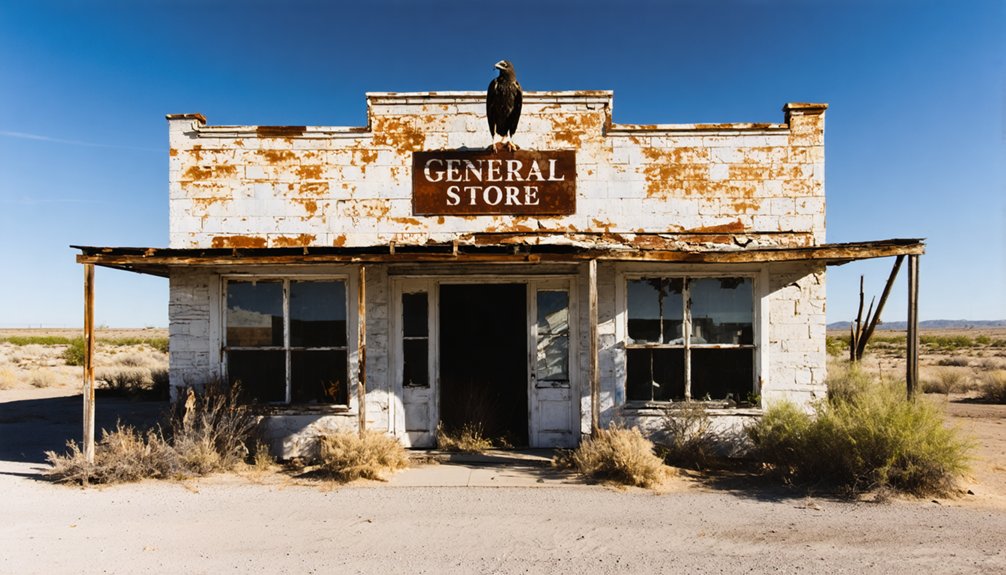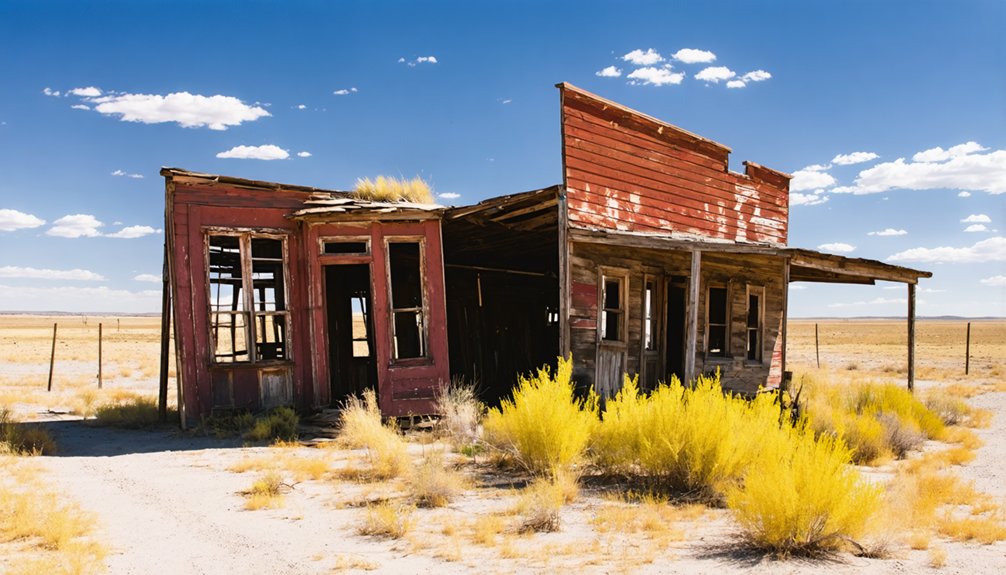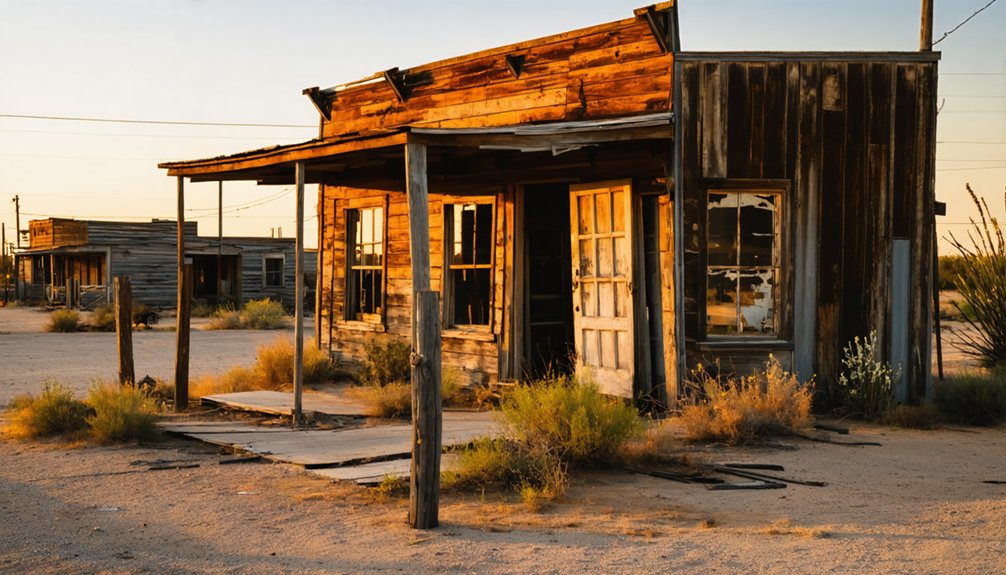You’ll find Madera Springs perched at 5,000 feet in Texas’s Davis Mountains, where natural springs once sustained life in the harsh Chihuahuan Desert. From 1964 to 1987, just two residents called this remote settlement home, managing daily survival through careful coordination and self-sufficiency. The ghost town‘s isolation, limited resources, and challenging high-desert climate ultimately led to its abandonment – a story that mirrors many temporary settlements across Texas’s pioneering frontier.
Key Takeaways
- Located at 5,000 feet elevation in Jeff Davis County, Texas, Madera Springs was sustained by natural springs in the Davis Mountains.
- The town experienced a dramatic decline, reaching a population of only two residents from 1964 to 1987 before complete abandonment.
- Geographic isolation and limited infrastructure made survival challenging, requiring residents to be largely self-sufficient for daily needs.
- Water sources from Solomon Spring and Toyah Creek initially supported the settlement but sparked tensions over water rights.
- The town’s abandonment resulted from harsh desert conditions, limited economic opportunities, and difficulties maintaining essential infrastructure.
The Hidden Springs of West Texas
While the arid expanses of West Texas may appear lifeless at first glance, a network of hidden springs sustained human settlements throughout the region’s history.
You’ll find these natural oases emerging from fault lines and aquifers, particularly in the Davis Mountains where Madera Springs sits at 4,961 feet elevation.
These springs aren’t just water sources – they’re gateways to hidden ecosystems thriving in the Chihuahuan Desert. Beneath limestone and shale layers, groundwater carries mineral deposits that shaped the region’s destiny, from supporting indigenous gatherings to fueling mining operations like those in mercury mining operations that once thrived in Terlingua. When cinnabar was discovered in the mid-1880s, the population of the area grew to 2,000 residents during the mining boom.
Hidden beneath the desert’s surface, mineral-rich springs transformed West Texas from barren wilderness into a hub of human civilization and industry.
The springs’ seasonal flows determined where travelers could rest, cattle could drink, and communities could grow. Even today, these water sources remain essential markers of the frontier spirit, preserving both natural habitats and stories of the American West.
Life in a Two-Person Town
From 1964 to 1987, you’d find just two residents maintaining their daily existence in Madera Springs, where routine tasks like property upkeep and basic survival necessitated careful coordination between the pair.
You’d notice how these individuals had to be largely self-sufficient, traveling to nearby communities for essentials like groceries and healthcare since no local services existed. Located at an altitude of 6,442 feet, the remote mountain setting added extra challenges to their isolated lifestyle.
The residents lived near the ruins of what was once the Madera Springs Resort, a former mountain retreat that had closed decades earlier due to water supply issues.
While physical isolation defined their experience, you’d observe how these residents likely maintained crucial connections to the outside world through periodic trips and possible visitors, essential for both practical needs and social contact.
Daily Routines and Survival
Living in a two-person ghost town demanded rigorous self-sufficiency and careful resource management. Your survival strategies had to account for the harsh semi-arid environment and extreme isolation.
Similar to the resilient residents of Belle Plain College, maintaining a sustainable existence required adapting to financial hardships and environmental challenges.
Daily tasks revolved around securing water from nearby springs, tending to personal gardens, and maintaining essential supplies through 14-mile trips to the nearest town.
You’d need to balance physical labor between property maintenance, firewood collection, and basic repairs while adapting to climate extremes.
Without municipal services, you’d manage your own waste removal and rely on stored propane or wood for cooking and heating.
The isolation meant you’d have to stockpile medications, handle emergencies independently, and maintain vigilant security measures.
Your day would follow careful routines, focusing on conservation and self-reliance while dealing with limited communication options and transportation challenges.
Maintaining Community Connections
Despite being limited to just two residents, maintaining social connections remains vital for survival in Madera Springs.
You’ll need to engage regularly with neighboring communities in Jeff Davis County, particularly Fort Davis, for essential services and social interaction. Community outreach involves frequent travel to regional events and gatherings, helping preserve your connection to the broader area’s cultural fabric. The Jeff Davis Disambiguation helps residents navigate the multiple counties sharing similar names.
Digital engagement through phones and internet becomes your lifeline to family and friends beyond the town’s borders. The Population Division estimates provide crucial data for understanding demographic shifts in the region.
You’ll rely heavily on technology to participate in county developments and stay informed about local government matters. When emergencies arise, you’ll coordinate with nearby towns for assistance, making these external relationships significant.
Regular participation in regional festivals and historical preservation efforts helps keep Madera Springs’ identity alive within the larger community network.
Geographic Features and Natural Setting
Madera Springs sits perched at nearly 5,000 feet above sea level in western Texas’s Jeff Davis County, approximately 14 miles southwest of Toyahvale. The community is officially recognized as an other community type within the county. Like many scattered ruins throughout Texas, only fragments of its past remain visible today.
You’ll find yourself surrounded by the rugged geological formations of the Davis Mountains, where desert ecosystems thrive in the Chihuahuan Desert‘s arid landscape.
If you’re drawn to untamed environments, you’ll appreciate these distinctive features:
- Natural springs that once sustained life in this harsh terrain, giving the town its namesake
- Dramatic temperature swings between day and night, typical of high-elevation desert climates
- Clear, dark skies that make this area prime territory for stargazing near the McDonald Observatory
The surrounding terrain showcases rocky outcrops, desert plains, and drought-resistant vegetation adapted to survive in this remote corner of West Texas.
Historical Timeline and Settlement
You’ll find Madera Springs’ early settlers faced typical challenges of West Texas frontier life, including the need to establish sustainable water sources and basic infrastructure in an arid environment.
The town’s population grew modestly during its initial decades, supported by local mining and ranching activities that drew settlers to the area.
Like many frontier settlements, Madera Springs’ future was heavily dependent on securing a railroad connection, though this vital transportation link often determined whether a town would thrive or fade away.
Early Settlement Challenges
During the late 19th century, settlers in the Madera Springs region faced formidable environmental and logistical challenges as they established their presence among indigenous communities.
You’ll find that settler hardships included harsh terrain, limited infrastructure, and the constant struggle for water access in this arid landscape.
- Settlers had to develop complex irrigation techniques, diverting water from sources like San Solomon Spring and Toyah Creek through carefully constructed canals.
- The region’s isolation complicated supply chains and market access, forcing settlers to become largely self-sufficient.
- Water rights became a source of tension between Anglo settlers, Mexican-descended farmers, and Native American groups who’d long cultivated the land.
Those who persevered built fortified homes and established farming operations, often relying on military experience to overcome these frontier challenges.
Population Through The Years
Although detailed population records from its early years remain scarce, the historical timeline of Madera Springs reveals a settlement that gradually faded into ghost town status by the mid-20th century.
The town experienced significant population fluctuations, mirroring the fate of many West Texas settlements where economic changes and transportation shifts drove residents away. By 1964, you’d have found just two inhabitants remaining, a number that held steady until 1987.
This minimal population reflected broader demographic shifts occurring throughout Texas, as people abandoned rural settlements for urban opportunities. Like many ghost towns in the region, Madera Springs’ decline was influenced by railroad routing decisions and the mechanization of agriculture, leaving behind a largely abandoned community.
The Path to Abandonment

While Madera Springs initially showed promise as a settlement due to its natural water source, several factors converged to seal its fate as a ghost town.
The harsh reality of isolation effects took their toll as the remote location cut the town off from essential supply routes and economic opportunities. These abandonment factors created a downward spiral that you couldn’t miss if you’d visited during its decline.
Major causes of Madera Springs’ demise:
- Geographic isolation at nearly 5,000 feet elevation made maintaining infrastructure and accessing supplies increasingly difficult.
- Lack of economic diversification beyond basic services for travelers and ranchers.
- Environmental challenges of the Chihuahuan Desert that raised maintenance costs and limited agricultural potential.
You’ll find that by 1964, the population had dwindled to just two residents, marking the town’s effective end.
Comparing Regional Ghost Towns
As you explore Texas ghost towns, you’ll discover distinct patterns of abandonment across the state’s diverse regions. When making regional comparisons, you’ll notice that High Plains ghost towns often emerged from failed agricultural ventures and railroad closures, while West Texas sites frequently tell stories of depleted mines and oil busts.
Along the coast, former port towns like Indianola succumbed to devastating storms and shifting maritime routes.
You’ll find that ghost town characteristics vary greatly by region. The High Plains area, particularly near Lubbock, continues to see accelerating population losses, with towns struggling to maintain essential services.
Meanwhile, ghost towns near the I-35 corridor face different pressures from expanding urban centers. Each region’s abandoned settlements serve as stark reminders of how economic changes and infrastructure decisions reshape Texas communities.
Legacy in Texas History

Moving beyond regional comparisons, Madera Springs stands as a compelling demonstration to Texas’s westward expansion and settlement patterns.
You’ll find its cultural significance embedded in the broader narrative of frontier development, where small communities emerged and faded based on economic factors and shifting transportation routes.
- The town’s brief existence reflects the challenges faced by frontier settlements, serving as a representation of the harsh realities of desert living and resource dependency.
- With a recorded population of just two residents from 1964 to 1987, it exemplifies the demographic shifts that transformed rural West Texas.
- Though abandoned, Madera Springs continues to serve as a valuable historical marker, illustrating how temporary settlements contributed to Texas’s development during its pioneering era.
Frequently Asked Questions
Are There Any Surviving Buildings or Structures in Madera Springs Today?
You won’t find any complete buildings standing today – only deteriorating foundations and scattered ruins remain. Without historical preservation efforts, these abandoned structures continue to decay into the Texas landscape.
What Were the Primary Occupations of the Two Residents Between 1964-1987?
You’ll find the two residents primarily engaged in ranching and water resource maintenance, while practicing self-sufficient homesteading techniques. Local legends suggest they also served as informal environmental stewards of the land.
Did Native American Tribes Use These Springs Before European Settlement?
Yes, archaeological evidence shows Native American tribal usage of these springs, including the Tonkawa, Karankawa, Comanche, and Pawnee tribes, who relied on the water source for hunting, gathering, and trade.
What Caused the Springs to Dry up or Diminish Over Time?
You’ll find water depletion occurred through natural geological shifts, over-extraction of groundwater, and climate change impacts. Both human activities and long-term environmental changes progressively diminished these essential desert springs.
Was There Ever a Post Office or General Store in Madera Springs?
Like a desert mirage, the post office you’re seeking existed briefly from 1926 to 1930, served by Gonzales Brothers, but there’s no evidence of a general store ever operating there.
References
- https://livefromthesouthside.com/10-texas-ghost-towns-to-visit/
- https://www.southernthing.com/ruins-in-texas-2640914879.html
- https://texashighways.com/travel-news/four-texas-ghost-towns/
- https://kids.kiddle.co/Madera_Springs
- https://en.wikipedia.org/wiki/Madera_Springs
- https://en.wikipedia.org/wiki/List_of_ghost_towns_in_Texas
- https://discovertexasoutdoors.com/places/madera-springs/
- https://www.twdb.texas.gov/publications/reports/numbered_reports/doc/R189/R189.pdf
- https://discovertexasoutdoors.com/places/madera-springs-texas-a-ghost-town-with-just-two-residents-in-its-history/
- https://a.osmarks.net/content/wikipedia_en_all_maxi_2020-08/A/Madera_Springs



